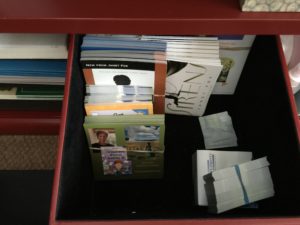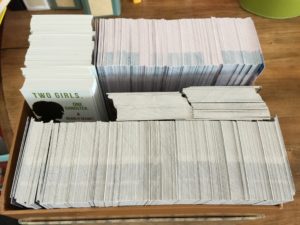Sometime over the holidays I watched a great interview with Roz Chast about her National Book Award-winning memoir Can’t We Talk About Something More Pleasant? During the interview photos of her aging parents’ apartment popped up: cluttered pencil drawers with stub ends, desks piled with random papers, tottering bookshelves. Chast described her parents as hoarders by default of their age.
To be clear, I’m not a hoarder. I hate mess. But I do like eye candy in the form of color and assorted knick-knacks, and my husband and I have inherited lots of family treasures, some quite nice.
Nevertheless, Chast’s photos gave me a bit of a chill, as I identified with drawers full of “stuff that might be useful some day” and “drawers containing things needing to be repaired”. I resolved to embark upon a January cleanup, inside and out.
What does this have to do with writing, you ask? Well, my office had become a repository for all the writerly things I’ve accumulated – bookmarks, post cards, outdated business cards, items I use at signings, items I use for giveaways. There was a lot of stuff, and most of it unnecessary.
Herewith, my advice for authors just starting out and thinking about what SWAG they might need:
- In my experience, the most useful items for writers are business cards and bookmarks. I’ve tried postcards, but I suggest you only get them if you intend to mail them as invitations to a book signing or announcements to booksellers. People don’t like to pick them up at signings because they’re big and can’t be used for anything.
- I’ve been to a couple of writers’ conferences with large swag bags full of giveaways. Some of the items were quite elaborate: printed velvet, door hang tags, key fobs, large pins. Hard items to toss, sure, but toss them I did, and I have never bought a book because I liked the SWAG. Never.
- Don’t buy huge quantities of anything. 1000 bookmarks? That’s what I did. Then, six months later, my book made a list, and I wanted that kudo on a new set of bookmarks, so the 500 or so remaining first gen bookmarks were useless. Just one of the stacks I recently recycled…
- Think carefully about layout and design. If you’re lucky, you might have an image that is significant and personal (I’ve branded around my name – Fox). You want the images you use to look fresh even several years down the road.
- An image of your book cover is a great idea, until the book goes to paperback with a different cover. Hence the reminder to buy small quantities.
- Business cards should look professional and feel nice in the hand. A good heavy card stock with a gloss finish on one side is ideal – the other side should be mostly blank for writing something personal if necessary. You won’t be handing out business cards to the general public. They’re for industry professionals – editors, agents, fellow writers, librarians, teachers. I’ve used Vistaprint, and MOO, and like them both, but there are many other companies.
- Bookmarks, too, should be relatively sturdy cardstock, and gloss one one side – some kids collect signed bookmarks, so one matte side for signing is nice. Include the following information: cover image, publisher, ISBN, your name, website, a tag line, abbreviated nice review, awards/stars. Most of mine are 2 inches by 6 inches. I’ve used my local printer but Overnight Prints and UPrinting are both recommended.
- Don’t make the mistake I’ve made of missing vital information. In one round of business cards (a nice collection of 250), I forgot to add my email, probably my single most important contact point. Hence 250 useless cards. Double and triple check.
That’s my set of suggestions. Hopefully you can avoid having to fill the recycling bin with paper products that don’t carry their share of the load, and avoid a clutter mess to clean out next year.


